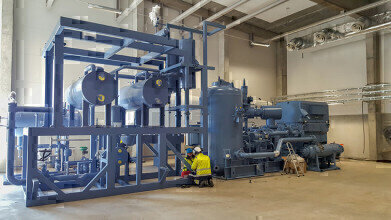Green Energy
Turning sewage waste into Energy
Jun 02 2021
Reducing greenhouse gas emissions from the heating supplied to a city in Sweden required a change in thinking by a major power company, using GEA’s energy-efficient heat pumps. After testing the water, a sewage plant was considered the best source for heating homes in an innovative approach for turning waste into usable energy.
GEA’s ammonia heat pumps were the ideal solution for district heating in southern Sweden, along with biomass and other renewable technologies to mitigate greenhouse gas emissions from heating. With a heating capacity of 10MW each, four GEA heat pumps were installed next to a sewage treatment plant and waste incinerator in the harbour area of the city of Malmö, where they are now providing 8% of the total energy to approximately 100,000 homes, the yearly equivalent usage of 10,000 households, contributing to around 50,000 tons of CO2 savings per year.
Heat pumps are fast becoming the technology of choice for renewable district and domestic heating to meet increasingly stringent environmental regulations and reduce CO2 emissions and operating costs. The heat pumps operating in Malmö use waste heat from sewage and waste incineration plants. E.ON decided to use recycled sewage water for the system due to the higher temperatures emitted by the sewage plant (14ËšC) – making the water warmer than the seawater near the city which was too cold for efficient use. Withdrawing 30MW of heat from the sewage water, the energy harvested is upgraded to useful heat for the district heating network, with the integrated heat pumps working in conjunction with the nearby waste incinerator plant. The heat pump is designed for delivering up to 80ËšC but will rarely be required to deliver temperatures above 71ËšC.
As fluorinated gases are phased out to meet with European F-Gas regulation, also designed to reduce greenhouse gas emissions, natural refrigerants are becoming more popular - especially ammonia, a climate-friendly refrigerant which is readily available, inexpensive and has no impact on global warming or ozone depletion.Whilst this is not the first time that heat pumps have been used in Sweden, the Malmo project is the first in the country to specify ammonia. E.ON opted for ammonia rather than chemical-based refrigerants due to the EU F-Gas regulation, which aims to phase down HFCs by 79% by 2030, and the company’s understanding of and commitment to its environmentally conscious customers.
Mats Egard, project manager at E.ON Värme Sverige AB, said: “It would have been cheaper to install an R134a heat pump, but we didn’t believe in that refrigerant for the future, because we are going to become 100% renewable. We’re going to supply district heating energy that is either recycled or renewable by 2025.” Kenneth Hoffmann, GEA’s Product Manager Heat Pumps, added: “Ammonia is the way forward into a sustainable future.”
Kenneth Hoffmann summed up the science behind the cost-effective heat pump technology that is transforming district and residential heating and is delivering the recycled energy that will keep the citizens of Malmö warm well into the future. He said: “The four heat pumps work in parallel to deliver the promised temperatures. Each has a coefficient of performance (COP) above 3.5, so for each 1kWh of electricity used by the heat pump, 3.5 kWh of heat is produced for the city.”
A heat pump system requires comprehensive analysis of the requested temperatures and assessment of the right process parameters. Every degree counts with a heat pump and the more accurate the initial design, the more energy can be saved. Instead of focusing on small pipes with large temperature difference to keep the initial cost down, a heat pump investment is based on continuous savings every day.
Heat pump technology delivers energy-saving advantages regardless of the industry in which it is used or the extent to which it is utilized. It can do basic jobs, like heating and cooling a small suburban home, right up to taking a central role in a super smart, zero-emissions strategy for district heating.
In countries where emission requirements are less stringent or where cap and trade policies allow, some manufacturers are choosing to maintain the status quo given that fossil fuels still tend to be cheaper than cleaner energy solutions. However, to meet sustainability goals the International Energy Agency (IEA) says that the share of clean energy technologies, such as heat pumps and solar thermal heating, needs to triple to more than one quarter of new heating equipment sales by 2030. So, let’s take action now and engineer for a better world together!
Events
IWA World Water Congress & Exhibition
Aug 11 2024 Toronto, Canada
Aug 25 2024 Stockholm, Sweden and online
Sep 03 2024 Mexico City, Mexico
Sep 03 2024 Mexico City, Mexico
Sep 03 2024 San Diego, CA, USA














